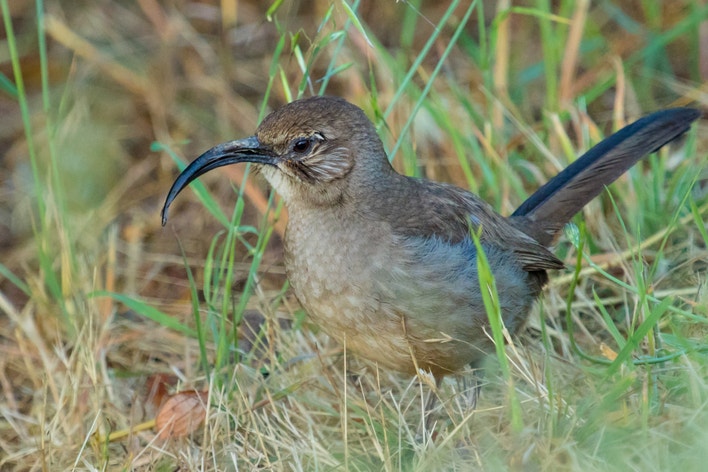California Thrasher
At a Glance
Several kinds of dull gray-brown thrashers occur in the West, but this is the only one along the California coast. The bird's normal range is limited to California and a corner of Baja, but within that range it is quite common in the chaparral, even coming into brushy suburbs. It spends most of its time on the ground, walking and running with its tail often held high, stopping to dig in the dirt with its sickle-shaped bill.
All bird guide text and rangemaps adapted from Lives of North American Birds by Kenn Kaufman© 1996, used by permission of Houghton Mifflin Harcourt Publishing Company. All rights reserved.
Category
Mockingbirds and Thrashers, Perching Birds
Conservation
Low Concern
Habitat
Fields, Meadows, and Grasslands, Forests and Woodlands, Shrublands, Savannas, and Thickets, Urban and Suburban Habitats
Region
California, Northwest
Behavior
Flitter, Running
Population
240.000
Range & Identification
Migration & Range Maps
Strictly permanent resident, rarely wandering even a short distance from breeding areas.
Description
11-13" (28-33 cm). Strongly curved bill, plain dark brown overall, with pale eyebrow, dark eyes, buff wash on belly.
Size
About the size of a Crow, About the size of a Robin
Color
Black, Brown, Gray, Red, Tan, White
Wing Shape
Broad
Tail Shape
Long, Rounded, Wedge-shaped
Songs and Calls
Song recalls that of a Northern Mockingbird, but harsher, more halting, and less repetitious. An expert mimic. Call a low harsh chuck and a throaty quip.
Call Pattern
Falling, Rising, Undulating
Call Type
Chirp/Chip, Trill, Whistle
Habitat
Chaparral, foothills, valley thickets, parks, gardens. Within its range, found in practically any lowland habitat with dense low brush. Most common in chaparral, also occurs in streamside thickets and in suburban neighborhoods that have enough vegetation. Extends into edges of desert regions, and in chaparral in mountains up to about 6,000'.
Sign up for Audubon's newsletter to learn more about birds like the California Thrasher
Behavior
Eggs
3-4, sometimes 2. Pale blue, evenly spotted with pale brown. Incubation is by both parents, about 14 days.
Young
Both parents feed nestlings. Young leave the nest after about 12-14 days, are unable to fly well for several more days. Male may care for young from 1st brood while female begins laying 2nd clutch. 2 broods per year, perhaps sometimes 3.
Feeding Behavior
Forages mostly on the ground, using its heavy curved bill to flip leaf-litter aside and to dig in the soil.
Diet
Mostly insects and berries. Feeds on a wide variety of insects, including ants, wasps, bees, beetles, caterpillars, moths, and many others. Also eats some spiders and centipedes. Berries and small fruits are important in diet, and eats seeds, acorns, and other plant material. Will come to bird feeders for miscellaneous scraps.
Nesting
Pairs may remain together on territory all year. Male sings to defend nesting territory, usually from top of shrub or tree; song often includes imitations of other birds. Nest: Placed in a dense shrub or extensive thickets, less than 10' above the ground, usually 2-4' up. Nest (built by both sexes) is a bulky open cup of sticks and twigs, lined with fine grass, weeds, rootlets, strips of bark, and other soft items.
Climate Vulnerability
Conservation Status
Has disappeared in many coastal areas with increasing urbanization, but still fairly widespread and common.
Climate Threats Facing the California Thrasher
Choose a temperature scenario below to see which threats will affect this species as warming increases. The same climate change-driven threats that put birds at risk will affect other wildlife and people, too.





